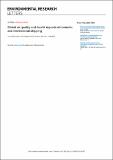Global air quality and health impacts of domestic and international shipping
Author(s)
Zhang, Yiqi; Eastham, Sebastian D; Lau, Alexis KH; Fung, Jimmy CH; Selin, Noelle E
DownloadPublished version (2.442Mb)
Publisher with Creative Commons License
Publisher with Creative Commons License
Creative Commons Attribution
Terms of use
Metadata
Show full item recordAbstract
<jats:title>Abstract</jats:title>
<jats:p>Shipping activities contribute to degraded air quality and premature mortalities worldwide, but previous assessments of their health impact have not yet differentiated contributions from domestic and international shipping at the global level. The impacts of domestic shipping can affect different populations, and domestic and international shipping emissions are governed under different regulatory systems. Thus, a consistent global analysis comparing the health impacts from domestic and international shipping could inform policy making in attempts to coordinate policies across multiple scales to address the health burden of shipping emissions. In this study, we create bottom-up global ship emission inventories based on ship activity records from the automatic identification system, and then apply the GEOS-Chem atmospheric model and global exposure mortality model to quanitfy shipping-related PM<jats:sub>2.5</jats:sub>-concentrations and associated mortalities. We also quantify the public health benefits under different control scenarios including the 2020 0.5% sulphur cap, a post-2020 0.1% sulphur cap, and a post-2020 Tier III NO<jats:italic>
<jats:sub>x</jats:sub>
</jats:italic> standard. We find that 94 200 (95% confidence interval: 84 800–103 000) premature deaths were associated with PM<jats:sub>2.5</jats:sub> exposure due to maritime shipping in 2015, of which 83% were associated with international shipping activities and 17% with domestic shipping. Although the global health burdens of ship emissions are dominated by international shipping, the fraction varies by region: 44% of shipping-related premature deaths in China come from domestic shipping activities. We estimate about 30 200 (27 200–33 000) avoided premature deaths per year under a scenario consistent with a 2020 0.5% sulphur cap. We find that a post-2020 Tier III NO<jats:italic>
<jats:sub>x</jats:sub>
</jats:italic> standard would have greater benefits than a post-2020 0.1% sulphur cap, with the two policies reducing annual shipping-attributable PM<jats:sub>2.5</jats:sub>-related premature deaths by 33 300 (30 100–36 400) and 5070 (4560–5540), respectively.</jats:p>
Date issued
2021Department
Massachusetts Institute of Technology. Joint Program on the Science & Policy of Global Change; Massachusetts Institute of Technology. Department of Aeronautics and Astronautics. Laboratory for Aviation and the Environment; Massachusetts Institute of Technology. Department of Earth, Atmospheric, and Planetary Sciences; Massachusetts Institute of Technology. Institute for Data, Systems, and SocietyJournal
Environmental Research Letters
Publisher
IOP Publishing
Citation
Zhang, Yiqi, Eastham, Sebastian D, Lau, Alexis KH, Fung, Jimmy CH and Selin, Noelle E. 2021. "Global air quality and health impacts of domestic and international shipping." Environmental Research Letters, 16 (8).
Version: Final published version